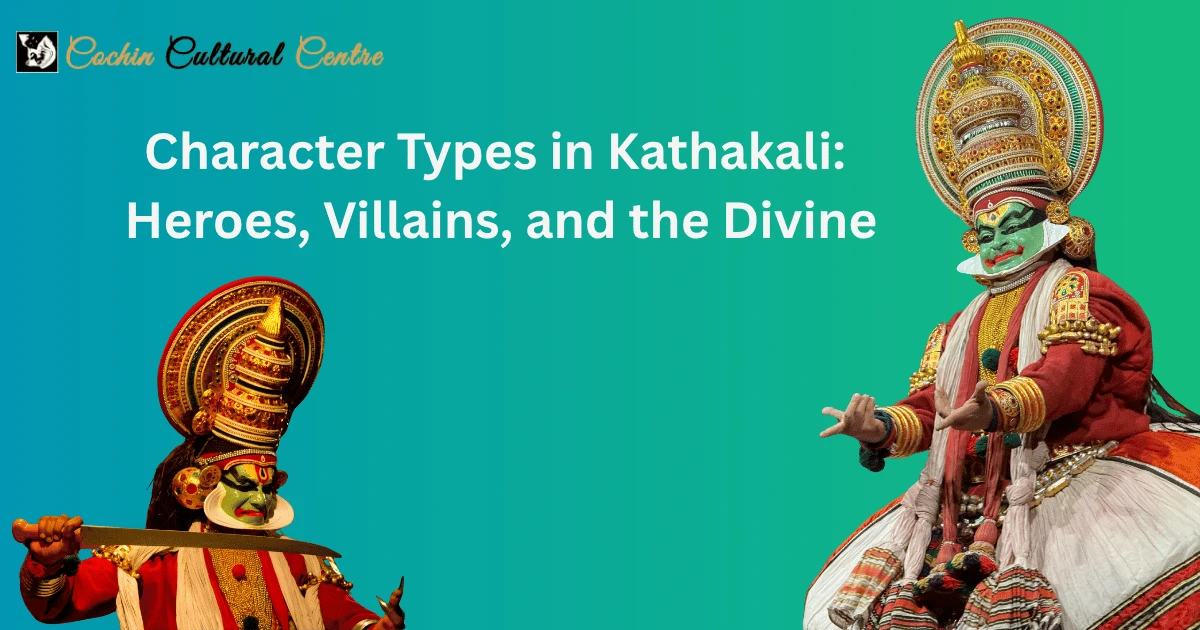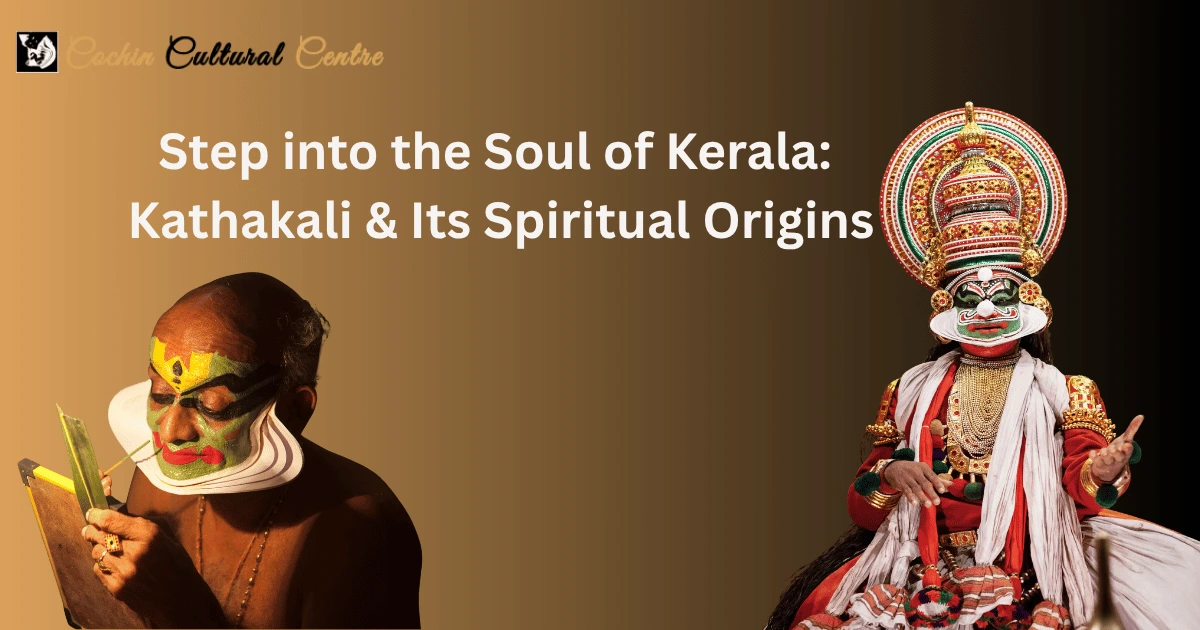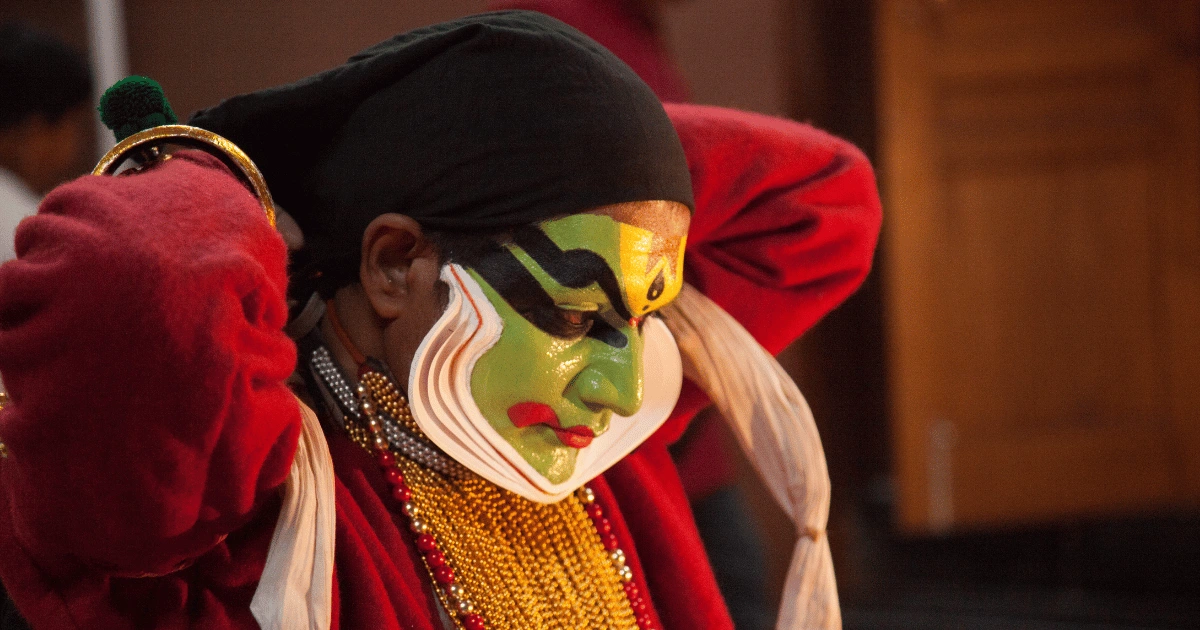Explore the vibrant personalities that bring Kerala’s classical theatre to life.
When the curtain rises at a Kathakali performance, the stage transforms into a mythical realm where gods, demons, kings, and sages come alive through powerful expressions, elaborate makeup, and stylized movements. Kathakali is not just a dance; it’s a visual storytelling tradition that thrives on strong, symbolic characters—each painted and portrayed with great precision.
At Cochin Cultural Centre, we present authentic Kathakali performances every evening in the heart of Fort Kochi, helping audiences decode the ancient language of gestures, colors, and expressions. In this blog, let’s delve into the three major character types in Kathakali: the Noble Heroes, the Fearsome Villains, and the Divine Beings.
The Heroes: Noble and Righteous
The Pacha (meaning “green”) characters represent the ideal heroes in Kathakali. With a bright green face, a well-defined white frame (chutti), and crown-like headgear, they symbolize nobility, virtue, and divine birth.
Common Heroic Characters:
- Rama (from Ramayana)
- Krishna (from Mahabharata & Bhagavata Purana)
- Arjuna (from Mahabharata)
Traits:
- Courageous, noble, and calm
- Embody dharma (righteousness) and spiritual wisdom
- Expressed through graceful movements and controlled expressions
These characters are central to many classic stories and often engage in moral battles with darker forces, reinforcing the core themes of good vs. evil.
The Villains: Ferocious and Unpredictable
Kathakali’s Kathi characters (meaning “knife”) are the villains or anti-heroes, known for their cunning, arrogance, or power-hungry nature. Though they often wear green faces like the heroes, they have red marks, fanged mouths, and raised eyebrows that signify inner corruption.
Common Villainous Characters:
- Ravana (the ten-headed demon king)
- Duryodhana (the antagonist from Mahabharata)
- Keechaka (lustful villain from Mahabharata)
Traits:
- Complex personalities—sometimes intelligent and brave, but morally flawed
- Represent ego, lust, greed, or pride
- Performances involve bold footwork, sharp gestures, and intense facial expressions
Villains in Kathakali are not caricatures; they are deep, layered, and pivotal to the drama. Their fall is often a lesson in humility and justice.
The Divine & Mythical Beings: Transcending Reality
Some Kathakali characters represent deities or supernatural beings—neither entirely good nor evil. These include gods, sages, spirits, and animal characters. They are often portrayed using distinct makeup codes such as Thadi (bearded) types or Minukku (shining, gentle characters).
Key Divine or Supernatural Types:
- Kari (Black-bearded demons) – Fierce forest-dwelling creatures
- Chuvanna Thadi (Red-bearded) – Extremely aggressive demonic figures
- Vella Thadi (White-bearded) – Represent Hanuman, the monkey god
- Minukku – Sages, gentle women, and celestial beings (like Sita or Damayanti)
Traits:
- Represent cosmic forces, mystical energy, or moral ambiguity
- Often dance in stylized rhythms and employ exaggerated expressions
- Captivate the audience with surreal costumes and transformative acting
These characters elevate the performance from mere storytelling to a spiritual spectacle.
Why Understanding Character Types Matters
For first-time viewers, the characters’ colorful appearances might feel overwhelming. But understanding Kathakali’s character types helps you appreciate the deep symbolism and layers of meaning in each story. At the Cochin Cultural Centre, our performances are designed with narration, explanations, and live demonstrations to help you decode the symbolism and connect emotionally with the characters.
Experience It Live at Cochin Cultural Centre
Whether you’re a culture enthusiast, tourist, or student of Indian classical arts, watching a Kathakali performance in Kerala is an unforgettable journey. At Cochin Cultural Centre, our experienced artists bring to life the epic characters of Kathakali every evening with passion and perfection.
Located in the heart of Fort Kochi
Daily Performances | 5:00 PM to 6:30 PM
Book Your Seats: www.Cochinculturalcentre.org
FAQs
Q1: How do I know which character is a hero or villain?
Look at the makeup and color codes—green = noble, red = evil, white = divine, black = demonic.
Q2: Is Kathakali only for those who know the stories?
Not at all. At our centre, we provide English explanations and live narration to guide you.
Q3: Are the characters male and female both?
Yes, though traditionally played by male artists, Kathakali includes both male and female roles, represented using different makeup styles.
Final Thoughts
The magic of Kathakali lies not just in its costumes or music, but in its characters—painted, powerful, and profoundly symbolic. From divine heroes to fearsome demons, each role has a story to tell, a lesson to impart, and a spell to cast.
Come, witness the mythical world of Kathakali unfold before your eyes—only at the Cochin Cultural Centre.



